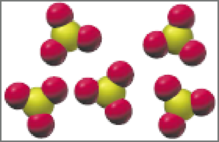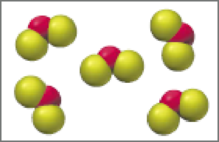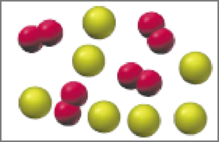
General Chemistry: Atoms First
2nd Edition
ISBN: 9780321809261
Author: John E. McMurry, Robert C. Fay
Publisher: Prentice Hall
expand_more
expand_more
format_list_bulleted
Concept explainers
Textbook Question
Chapter 1, Problem 1.24CP
If yellow spheres represent sulfur atoms and red spheres represent oxygen atoms, which of the following drawings shows a collection of sulfur dioxide (SO2) units?




Expert Solution & Answer
Want to see the full answer?
Check out a sample textbook solution
Students have asked these similar questions
NMR spectrum of ethyl acetate has signals whose chemical shifts are indicated below. Which hydrogen or set of hydrogens corresponds to the signal at
4.1 ppm? Select the single best answer.
The
H
O
HỌC—C—0—CH, CH,
2
A
ethyl acetate
H NMR: 1.3 ppm, 2.0 ppm, 4.1 ppm
Check
OA
B
OC
ch
B
C
Save For Later
Submit Ass
© 2025 McGraw Hill LLC. All Rights Reserved. Terms of Use | Privacy Center |
How many signals do you expect in the H NMR spectrum for this molecule?
Br Br
Write the answer below.
Also, in each of the drawing areas below is a copy of the molecule, with Hs shown. In each copy, one of the H atoms is colored red. Highlight in red all other H
atoms that would contribute to the same signal as the H already highlighted red
Note for advanced students: In this question, any multiplet is counted as one signal.
1
Number of signals in the 'H NMR spectrum.
For the molecule in the top drawing area, highlight in red any other H atoms that will contribute to
the same signal as the H atom already highlighted red.
If no other H atoms will contribute, check the box at right.
Check
For the molecule in the bottom drawing area, highlight in red any other H atoms that will contribute
to the same signal as the H atom already highlighted red.
If no other H atoms will contribute, check the box at right.
O
✓
No additional Hs to color in top
molecule
ง
No additional Hs to color in bottom…
in the kinetics experiment, what were the values calculated? Select all that apply.a) equilibrium constantb) pHc) order of reactiond) rate contstant
Chapter 1 Solutions
General Chemistry: Atoms First
Ch. 1.1 - Look at the alphabetical list of elements inside...Ch. 1.1 - Prob. 1.2PCh. 1.3 - Identify the following elements as metals,...Ch. 1.3 - Prob. 1.4CPCh. 1.5 - Compounds A and B are colorless gases obtained by...Ch. 1.7 - The gold foil Rutherford used in his scattering...Ch. 1.7 - A small speck of carbon the size of a pinhead...Ch. 1.8 - The isotope S3475e is used medically for the...Ch. 1.8 - Chlorine, one of the elements in common table salt...Ch. 1.8 - An atom of element X contains 47 protons and 62...
Ch. 1.9 - Copper metal has two naturally occurring isotopes:...Ch. 1.9 - Based on your answer to Problem 1.11, how many...Ch. 1.9 - What is the mass in grams of each of the following...Ch. 1.9 - How many moles are in each of the following...Ch. 1.11 - Prob. 1.15PCh. 1.11 - Prob. 1.16PCh. 1.11 - Prob. 1.17CPCh. 1.11 - Prob. 1.18PCh. 1.11 - Prob. 1.19PCh. 1 - Prob. 1.20CPCh. 1 - Where on the following outline of a periodic table...Ch. 1 - Prob. 1.22CPCh. 1 - Prob. 1.23CPCh. 1 - If yellow spheres represent sulfur atoms and red...Ch. 1 - Prob. 1.25CPCh. 1 - Prob. 1.26CPCh. 1 - Prob. 1.27CPCh. 1 - In the following drawings, red spheres represent...Ch. 1 - Isotope A decays to isotope E through the...Ch. 1 - Prob. 1.30SPCh. 1 - Prob. 1.31SPCh. 1 - Prob. 1.32SPCh. 1 - Prob. 1.33SPCh. 1 - Prob. 1.34SPCh. 1 - Prob. 1.35SPCh. 1 - Prob. 1.36SPCh. 1 - Prob. 1.37SPCh. 1 - Prob. 1.38SPCh. 1 - Prob. 1.39SPCh. 1 - Prob. 1.40SPCh. 1 - Prob. 1.41SPCh. 1 - Prob. 1.42SPCh. 1 - Prob. 1.43SPCh. 1 - Prob. 1.44SPCh. 1 - Prob. 1.45SPCh. 1 - Prob. 1.46SPCh. 1 - Prob. 1.47SPCh. 1 - Prob. 1.48SPCh. 1 - Prob. 1.49SPCh. 1 - Prob. 1.50SPCh. 1 - Prob. 1.51SPCh. 1 - Prob. 1.52SPCh. 1 - Prob. 1.53SPCh. 1 - Prob. 1.54SPCh. 1 - Prob. 1.55SPCh. 1 - Prob. 1.56SPCh. 1 - Prob. 1.57SPCh. 1 - Prob. 1.58SPCh. 1 - Prob. 1.59SPCh. 1 - Prob. 1.60SPCh. 1 - If 6.02 1023 atoms of element Y have a mass of...Ch. 1 - Prob. 1.62SPCh. 1 - Prob. 1.63SPCh. 1 - Prob. 1.64SPCh. 1 - Prob. 1.65SPCh. 1 - Prob. 1.66SPCh. 1 - Prob. 1.67SPCh. 1 - Prob. 1.68SPCh. 1 - Prob. 1.69SPCh. 1 - Prob. 1.70SPCh. 1 - Prob. 1.71SPCh. 1 - Prob. 1.72SPCh. 1 - Prob. 1.73SPCh. 1 - Prob. 1.74SPCh. 1 - Prob. 1.75SPCh. 1 - Prob. 1.76SPCh. 1 - Prob. 1.77SPCh. 1 - Prob. 1.78SPCh. 1 - Prob. 1.79SPCh. 1 - Prob. 1.80SPCh. 1 - Prob. 1.81SPCh. 1 - Prob. 1.82SPCh. 1 - Which of the following isotope symbols cant be...Ch. 1 - Prob. 1.84SPCh. 1 - Naturally occurring silver consists of two...Ch. 1 - Magnesium has three naturally occurring isotopes:...Ch. 1 - Prob. 1.87SPCh. 1 - Prob. 1.88SPCh. 1 - Prob. 1.89SPCh. 1 - Prob. 1.90SPCh. 1 - Prob. 1.91SPCh. 1 - Prob. 1.92SPCh. 1 - Prob. 1.93SPCh. 1 - Prob. 1.94SPCh. 1 - Prob. 1.95SPCh. 1 - Prob. 1.96SPCh. 1 - Prob. 1.97SPCh. 1 - Prob. 1.98SPCh. 1 - Prob. 1.99SPCh. 1 - Prob. 1.100SPCh. 1 - Prob. 1.101SPCh. 1 - Prob. 1.102CHPCh. 1 - Prob. 1.103CHPCh. 1 - Prob. 1.104CHPCh. 1 - Prob. 1.105CHPCh. 1 - Prob. 1.106CHPCh. 1 - Prob. 1.107CHPCh. 1 - Prob. 1.108CHPCh. 1 - Prob. 1.109CHPCh. 1 - Prob. 1.110CHPCh. 1 - The mass percent of an element in a compound is...Ch. 1 - Prob. 1.112CHPCh. 1 - Prob. 1.113CHPCh. 1 - In an alternate universe, the smallest negatively...
Knowledge Booster
Learn more about
Need a deep-dive on the concept behind this application? Look no further. Learn more about this topic, chemistry and related others by exploring similar questions and additional content below.Similar questions
- true or false, given that a 20.00 mL sample of NaOH took 24.15 mL of 0.141 M HCI to reach the endpoint in a titration, the concentration of the NaOH is 1.17 M.arrow_forwardin the bromothymol blue experiment, pKa was measured. A closely related compound has a Ka of 2.10 x 10-5. What is the pKa?a) 7.1b) 4.7c) 2.0arrow_forwardcalculate the equilibrium concentration of H2 given that K= 0.017 at a constant temperature for this reaction. The inital concentration of HBr is 0.050 M.2HBr(g) ↔ H2(g) + Br2(g)a) 4.48 x 10-2 M b) 5.17 x 10-3 Mc) 1.03 x 10-2 Md) 1.70 x 10-2 Marrow_forward
- true or falsegiven these two equilibria with their equilibrium constants:H2(g) + CI2(l) ↔ 2HCI(g) K= 0.006 CI2(l) ↔ CI2(g) K= 0.30The equilibrium contstant for the following reaction is 1.8H2(g) + CI2 ↔ 2HCI(g)arrow_forwardI2(g) + CI2(g) ↔ 2ICIK for this reaction is 81.9. Find the equilibrium concentration of I2 if the inital concentration of I2 and CI2 are 0.010 Marrow_forwardtrue or false,the equilibrium constant for this reaction is 0.50.PCI5(g) ↔ PCI3(g) + CI2(g)Based on the above, the equilibrium constant for the following reaction is 0.25.2PCI5(g) ↔. 2PCI3(g) + 2CI2(g)arrow_forward
- true or false, using the following equilibrium, if carbon dioxide is added the equilibrium will shift toward the productsC(s) + CO2(g) ↔ 2CO(g)arrow_forward2S2O2/3- (aq) + I2 (aq) ---> S4O2/6- (aq) +2I- (aq) Experiment I2 (M) S2O3- (M) Initital Rate (M/s) 1 0.01 0.01 0.0004 2 0.01 0.02 0.0004 3 0.02 0.01 0.0008 Calculate the overall order for this reaction using the table data a) 3b) 0c) 2d) 1arrow_forwardthe decomposition of N2O5 is the first order with a half-life of 1.98 minutes. If the inital concentration of N2O5 is 0.200 M, what is the concentration after 6 minutes?a) 0.612 Mb) 0.035 Mc) 0.024 Md) 0.100 Marrow_forward
- 20.00 mL of 0.150 M HCI is titrated with 0.075 M NaOH. What volume of NaOH is needed?a) 50 mLb) 20 mLc) 40 mLd) 26.66 mLarrow_forward20.00 mL of 0.150 M NaOH is titrated with 37.75 mL of HCI. What is the molarity of the HCI?a) 0.150 Mb) 0.079 Mc) 0.025 Md) 0.050 Marrow_forwardin the following reaction, the OH- acts as which of these?NO2- (aq) + H2O (l) ⇌ OH- (aq) + HNO2 (aq)a) not a weak acidb) basec) acidarrow_forward
arrow_back_ios
SEE MORE QUESTIONS
arrow_forward_ios
Recommended textbooks for you
 Introductory Chemistry: A FoundationChemistryISBN:9781337399425Author:Steven S. Zumdahl, Donald J. DeCostePublisher:Cengage Learning
Introductory Chemistry: A FoundationChemistryISBN:9781337399425Author:Steven S. Zumdahl, Donald J. DeCostePublisher:Cengage Learning Chemistry: Principles and PracticeChemistryISBN:9780534420123Author:Daniel L. Reger, Scott R. Goode, David W. Ball, Edward MercerPublisher:Cengage Learning
Chemistry: Principles and PracticeChemistryISBN:9780534420123Author:Daniel L. Reger, Scott R. Goode, David W. Ball, Edward MercerPublisher:Cengage Learning Introduction to General, Organic and BiochemistryChemistryISBN:9781285869759Author:Frederick A. Bettelheim, William H. Brown, Mary K. Campbell, Shawn O. Farrell, Omar TorresPublisher:Cengage Learning
Introduction to General, Organic and BiochemistryChemistryISBN:9781285869759Author:Frederick A. Bettelheim, William H. Brown, Mary K. Campbell, Shawn O. Farrell, Omar TorresPublisher:Cengage Learning ChemistryChemistryISBN:9781305957404Author:Steven S. Zumdahl, Susan A. Zumdahl, Donald J. DeCostePublisher:Cengage Learning
ChemistryChemistryISBN:9781305957404Author:Steven S. Zumdahl, Susan A. Zumdahl, Donald J. DeCostePublisher:Cengage Learning
 Living By Chemistry: First Edition TextbookChemistryISBN:9781559539418Author:Angelica StacyPublisher:MAC HIGHER
Living By Chemistry: First Edition TextbookChemistryISBN:9781559539418Author:Angelica StacyPublisher:MAC HIGHER

Introductory Chemistry: A Foundation
Chemistry
ISBN:9781337399425
Author:Steven S. Zumdahl, Donald J. DeCoste
Publisher:Cengage Learning

Chemistry: Principles and Practice
Chemistry
ISBN:9780534420123
Author:Daniel L. Reger, Scott R. Goode, David W. Ball, Edward Mercer
Publisher:Cengage Learning

Introduction to General, Organic and Biochemistry
Chemistry
ISBN:9781285869759
Author:Frederick A. Bettelheim, William H. Brown, Mary K. Campbell, Shawn O. Farrell, Omar Torres
Publisher:Cengage Learning

Chemistry
Chemistry
ISBN:9781305957404
Author:Steven S. Zumdahl, Susan A. Zumdahl, Donald J. DeCoste
Publisher:Cengage Learning


Living By Chemistry: First Edition Textbook
Chemistry
ISBN:9781559539418
Author:Angelica Stacy
Publisher:MAC HIGHER
Atomic Number, Atomic Mass, and the Atomic Structure | How to Pass ChemistryThe Nucleus: Crash Course Chemistry #1; Author: Crash Course;https://www.youtube.com/watch?v=FSyAehMdpyI;License: Standard YouTube License, CC-BY